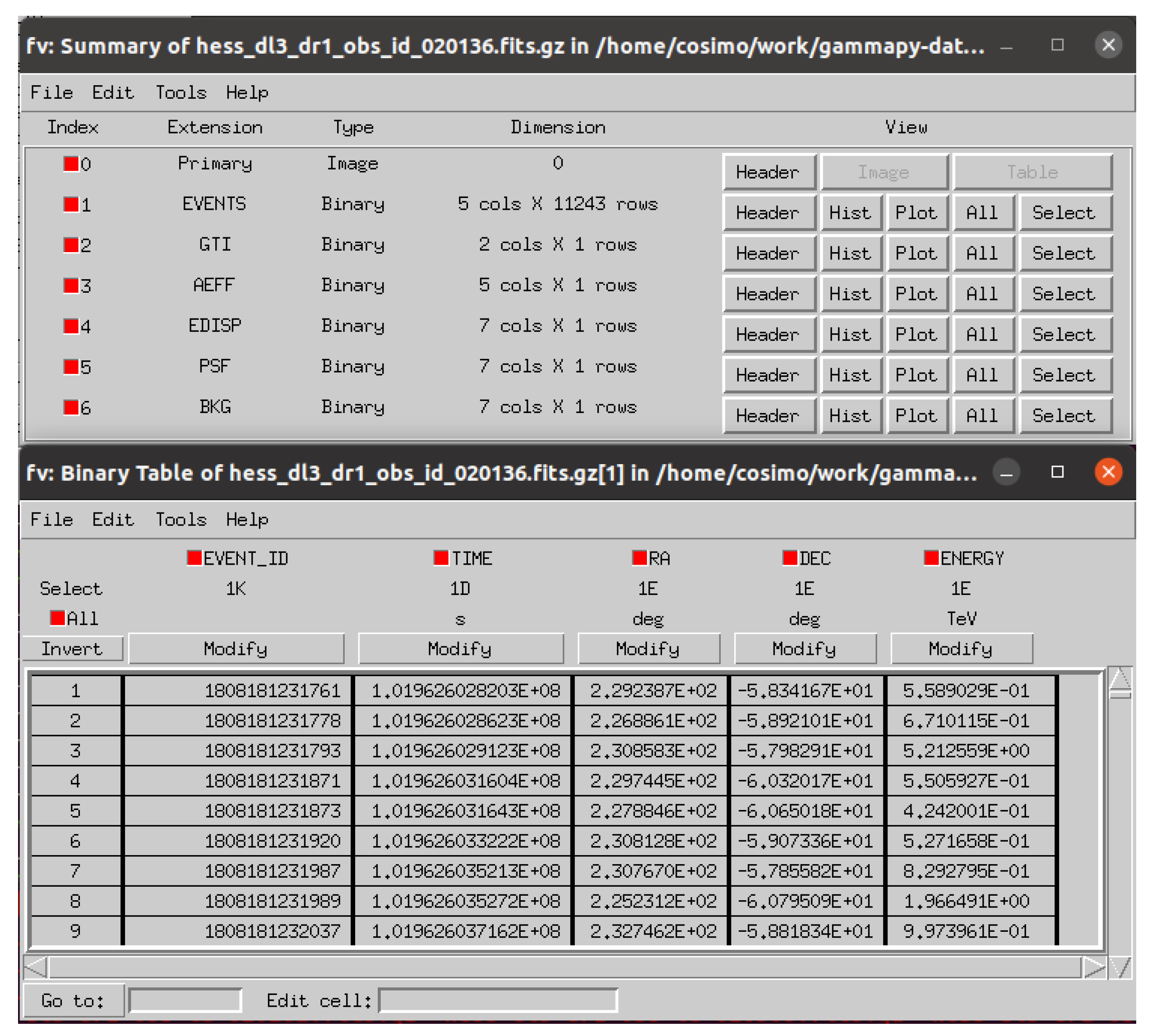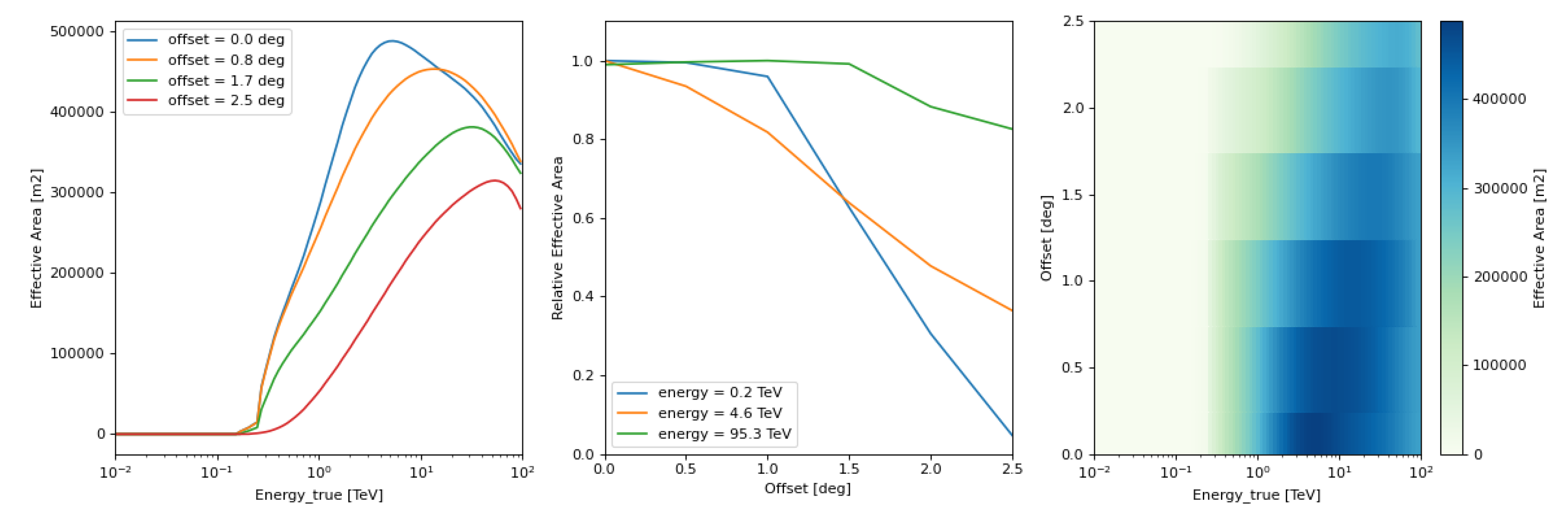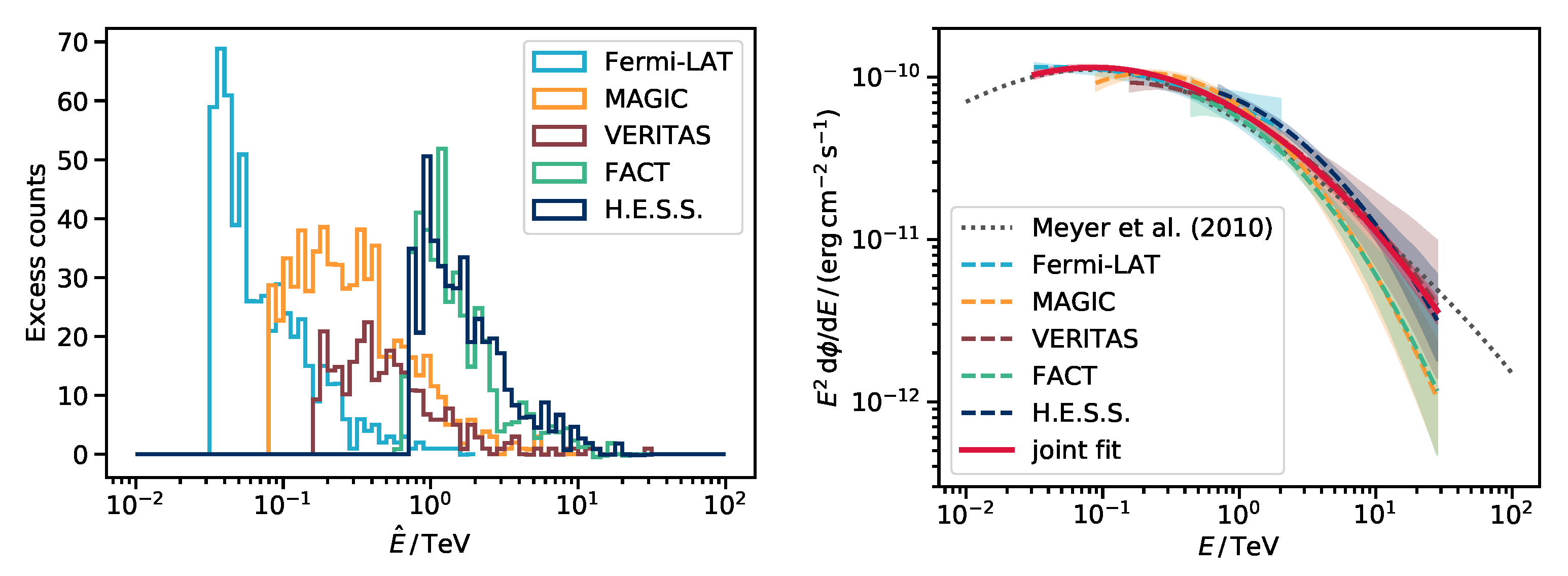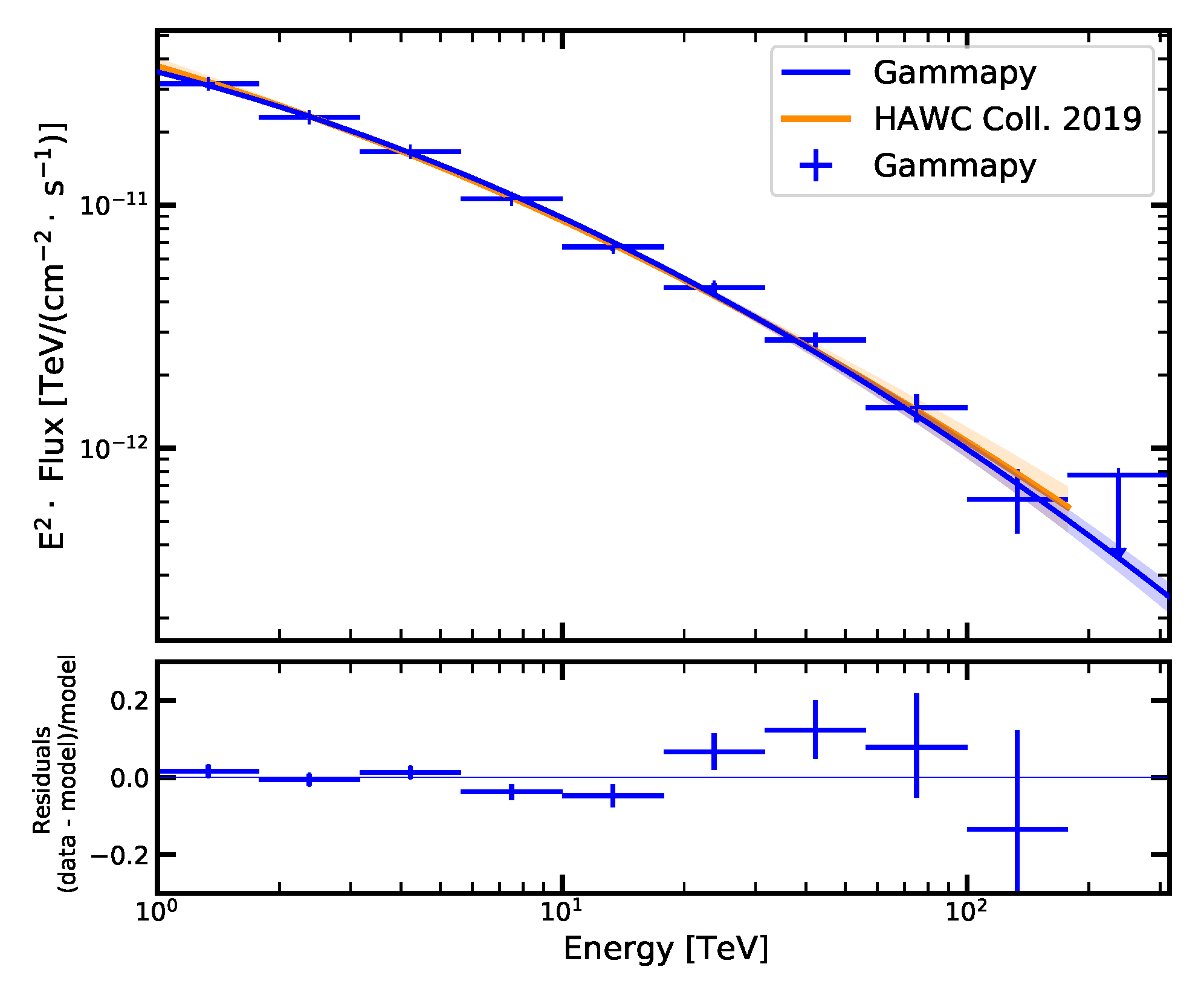Evolution of Data Formats in Very-High-Energy Gamma-Ray Astronomy
Abstract
:1. Introduction
2. Data Formats for Very-High-Energy Gamma-Ray Astronomy
2.1. Background: Data Model in the Current Generation of VHE Instruments
2.2. GADF: A Unifying Effort
2.2.1. Format Specifications
2.2.2. GADF DL3 Data
3. Projects Successfully Using the Standardised Data Format
3.1. The H.E.S.S. First Public Test Data Release
3.2. The Joint-Crab Project
- of Fermi-LAT observations, obtained in the custom high-level, DL3, format with which they are publicly released. They were reduced, before the final statistical analysis, to OGIP spectral data;
- of H.E.S.S. observations selected from the H.E.S.S. DL3 DR1 (see Section 3.1);
- of MAGIC observations produced and released specifically for this project;
- of VERITAS observations produced and released specifically for this project;
- of FACT observations from their already public data sample (see Section 2.1).
3.3. Analysis of the H.E.S.S. Public Data Release with Ctools
3.4. Validation of Open-Source Science Tools and Background Model Construction in -ray Astronomy
3.5. Open and Standardised Formats for -Ray Analysis Applied to HAWC Observatory Data
4. Discussion
5. Conclusions
Author Contributions
Funding
Acknowledgments
Conflicts of Interest
References
- Funk, S. Ground- and Space-Based Gamma-ray Astronomy. Annu. Rev. Nucl. Part. Sci. 2015, 65, 245–277. [Google Scholar] [CrossRef] [Green Version]
- Thompson, D.J. Space detectors for gamma rays (100 MeV-100 GeV): From EGRET to Fermi LAT. Comptes Rendus Phys. 2015, 16, 600–609. [Google Scholar] [CrossRef] [Green Version]
- de Naurois, M.; Mazin, D. Ground-based detectors in very-high-energy gamma-ray astronomy. Comptes Rendus Phys. 2015, 16, 610–627. [Google Scholar] [CrossRef] [Green Version]
- Cherenkov Telescope Array Consortium. Science with the Cherenkov Telescope Array; World Scientific Publishing Co. Pte. Ltd.: Singapore, 2019. [Google Scholar] [CrossRef] [Green Version]
- Bai, X.; Bi, B.Y.; Bi, X.J.; Cao, Z.; Chen, S.Z.; Chen, Y.; Chiavassa, A.; Cui, X.H.; Dai, Z.G.; della Volpe, D.; et al. The Large High Altitude Air Shower Observatory (LHAASO) Science White Paper. arXiv 2019, arXiv:1905.02773. [Google Scholar]
- Albert, A.; Alfaro, R.; Ashkar, H.; Alvarez, C.; Alvarez, J.; Arteaga-Velázquez, J.C.; Ayala Solares, H.A.; Arceo, R.; Bellido, J.A.; BenZvi, S.; et al. Science Case for a Wide Field-of-View Very-High-Energy Gamma-ray Observatory in the Southern Hemisphere. arXiv 2019, arXiv:1902.08429. [Google Scholar]
- National Aeronautics and Space Administration (NASA). Fermi Data Policy. Available online: https://fermi.gsfc.nasa.gov/ssc/data/policy/ (accessed on 28 September 2021).
- Pittori, C.; The Agile-SSDC Team. The AGILE data center and its legacy. Rend. Lincei Sci. Fis. Nat. 2019, 30, 217–223. [Google Scholar] [CrossRef] [Green Version]
- National Aeronautics and Space Administration (NASA). Fermi Science Support Center. Available online: https://fermi.gsfc.nasa.gov/ssc/ (accessed on 28 September 2021).
- Space Science Data Center (SSDC). AGILE Data Center. Available online: https://agile.ssdc.asi.it/ (accessed on 28 September 2021).
- Zanin, R.; Carmona, E.; Sitarek, J.; Colin, P.; Frantzen, K.; Gaug, M.; Lombardi, S.; Lopez, M.; Moralejo, A.; Satalecka, K.; et al. MARS, The MAGIC Analysis and Reconstruction Software. In Proceedings of the 33rd International Cosmic ray Conference (ICRC2013), Rio de Janeiro, Brasil, 2–6 July 2013; Volume 33, p. 2937. [Google Scholar]
- Khelifi, B.; Djannati-Ataï, A.; Jouvin, L.; Lefaucheur, J.; Lemiere, A.; Pita, S.; Tavernier, T.; Terrier, R. HAP-Fr, a pipeline of data analysis for the HESS-II experiment. In Proceedings of the 34th International Cosmic ray Conference (ICRC2015), The Hague, The Netherlands, 30 July–6 August 2015; Volume 34, p. 837. [Google Scholar]
- Maier, G.; Holder, J. Eventdisplay: An Analysis and Reconstruction Package for Ground-based Gamma-ray Astronomy. In Proceedings of the 35th International Cosmic ray Conference (ICRC2017), Busan, Korea, 12–20 July 2017; Volume 301, p. 747. [Google Scholar]
- Brügge, K.; Nöthe, M.; Buß, J.; Temme, T.F.; Bulinski, M.; Mueller, S.A.; Bockermann, C.; Linhoff, L.; Freiwald, J.; Neise, D.; et al. Fact-tools. Zenodo 2019. [Google Scholar] [CrossRef]
- FACT Collaboration. FACT Open Data. Available online: https://fact-project.org/data/ (accessed on 28 September 2021).
- HAWC Observatory. Public Datasets. Available online: https://data.hawc-observatory.org/ (accessed on 28 September 2021).
- Lamanna, G.; Antonelli, L.A.; Contreras, J.L.; Knödlseder, J.; Kosack, K.; Neyroud, N.; Aboudan, A.; Arrabito, L.; Barbier, C.; Bastieri, D.; et al. Cherenkov Telescope Array Data Management. In Proceedings of the 34th International Cosmic ray Conference (ICRC2015), The Hague, The Netherlands, 30 July–6 August 2015; Volume 34, p. 947. [Google Scholar]
- Knödlseder, J.; Mayer, M.; Deil, C.; Cayrou, J.-B.; Owen, E.; Kelley-Hoskins, N.; Lu, C.-C.; Buehler, R.; Forest, F.; Louge, T.; et al. GammaLib and ctools. A software framework for the analysis of astronomical gamma-ray data. Astron. Astrophys. 2016, 593, A1. [Google Scholar] [CrossRef] [Green Version]
- Deil, C.; Zanin, R.; Lefaucheur, J.; Boisson, C.; Khélifi, B.; Terrier, R.; Wood, M.; Mohrmann, L.; Chakraborty, N.; Watson, J.; et al. Gammapy—A prototype for the CTA science tools. In Proceedings of the 35th International Cosmic ray Conference (ICRC2017), Busan, Korea, 12–20 July 2017; Volume 301, p. 766. [Google Scholar]
- Brun, R.; Rademakers, F. ROOT—An object oriented data analysis framework. Nucl. Instrum. Methods Phys. Res. A 1997, 389, 81–86. [Google Scholar] [CrossRef]
- Cogan, P. VEGAS, the VERITAS Gamma-ray Analysis Suite. In Proceedings of the 30th International Cosmic Ray Conference (ICRC2007), Mérida, Yucatán, Mexico, 3–11 July 2007; Volume 3, pp. 1385–1388. [Google Scholar]
- Nigro, C. Study of Persistent and Flaring Gamma-ray Emission from Active Galactic Nuclei with the MAGIC Telescopes and Prospects for Future Open Data Formats in Gamma-ray Astronomy. Ph.D. Thesis, Humboldt-Universität zu Berlin, Mathematisch-Naturwissenschaftliche Fakultät, Berlin, Germany, 2019. [Google Scholar] [CrossRef]
- Hillas, A.M. Cerenkov Light Images of EAS Produced by Primary Gamma rays and by Nuclei. In Proceedings of the 19th International Cosmic ray Conference, San Diego, CA, USA, 11–23 August 1985; Volume 3, p. 445. [Google Scholar]
- Abeysekara, A.U.; Albert, A.; Alfaro, R.; Alvarez, C.; Álvarez, J.D.; Arceo, R.; Arteaga-Velázquez, J.C.; Ayala Solares, H.A.; Barber, A.S.; Bautista-Elivar, N.; et al. Observation of the Crab Nebula with the HAWC Gamma-ray Observatory. Astrophys. J. 2017, 843, 39. [Google Scholar] [CrossRef]
- Vianello, G.; Lauer, R.; Burgess, J.M.; Ayala, H.; Fleischhack, H.; Harding, P.; Hui, M.; Marinelli, S.; Savchenko, V.; Zhou, H. The Multi-Mission Maximum Likelihood framework (3ML). arXiv 2015, arXiv:1507.08343. [Google Scholar]
- Deil, C.; Boisson, C.; Kosack, K.; Perkins, J.; King, J.; Eger, P.; Mayer, M.; Wood, M.; Zabalza, V.; Knödlseder, J.; et al. Open high-level data formats and software for gamma-ray astronomy. In Proceedings of the 6th International Symposium on High Energy Gamma-ray Astronomy, Heidelberg, Germany, 11–15 July 2016; American Institute of Physics Conference Series. Volume 1792, p. 070006. [Google Scholar] [CrossRef]
- Data Formats for Gamma-ray Astronomy. Online Documentation. Available online: https://gamma-astro-data-formats.readthedocs.io/ (accessed on 28 September 2021).
- Data Formats for Gamma-ray Astronomy. GitHub Repository. Available online: https://github.com/open-gamma-ray-astro/gamma-astro-data-formats (accessed on 28 September 2021).
- Deil, C.; Wood, M.; Hassan, T.; Boisson, C.; Contreras, J.L.; Knödlseder, J.; Khelifi, B.; King, J.; Mohrmann, L. Data Formats for Gamma-ray Astronomy—Version 0.2. Zenodo 2018. [Google Scholar] [CrossRef]
- Contreras, J.L.; Satalecka, K.; Bernlöhr, K.; Boisson, C.; Bregeon, J.; Bulgarelli, A.; de Cesare, G.; de los Reyes, R.; Fioretti, V.; Kosack, K.; et al. Data model issues in the Cherenkov Telescope Array project. In Proceedings of the 34th International Cosmic ray Conference (ICRC2015), The Hague, The Netherlands, 30 July–6 August 2015; Volume 34, p. 960. [Google Scholar]
- Wells, D.C.; Greisen, E.W.; Harten, R.H. FITS - A Flexible Image Transport System. Astron. Astrophys. Suppl. Ser. 1981, 44, 363. [Google Scholar]
- National Aeronautics and Space Administration (NASA). High Energy Astrophysics Science Archive Research Center. Available online: https://heasarc.gsfc.nasa.gov/ (accessed on 28 September 2021).
- Corcoran, M.F.; Angelini, L.; George, I.; McGlynn, T.; Mukai, K.; Pence, W.; Rots, A. The OGIP FITS Working Group. Astronomical Data Analysis Software and Systems IV. Shaw, R.A., Payne, H.E., Hayes, J.J.E., Eds.; 1995, Volume 77, p. 219. Available online: https://www.adass.org/adass/proceedings/adass94/corcoranm.html (accessed on 26 September 2021).
- National Aeronautics and Space Administration (NASA). FTOOLS: A General Package of Software to Manipulate FITS Files. Available online: https://heasarc.gsfc.nasa.gov/ftools/ (accessed on 28 September 2021).
- Arnaud, K.A.; George, I.M. The OGIP Spectral File Format, OGIP Memo OGIP/92-007. Available online: https://heasarc.gsfc.nasa.gov/docs/heasarc/ofwg/docs/spectra/ogip_92_007/ogip_92_007.html (accessed on 28 September 2021).
- Freeman, P.; Doe, S.; Siemiginowska, A. Sherpa: A mission-independent data analysis application. Astronomical Data Analysis. Starck, J.L., Murtagh, F.D., Eds.; 2001, 4477, pp. 76–87. Available online: https://www.spiedigitallibrary.org/conference-proceedings-of-spie/4477/1/Sherpa-a-mission-independent-data-analysis-application/10.1117/12.447161.short (accessed on 26 September 2021).
- Doe, S.; Nguyen, D.; Stawarz, C.; Refsdal, B.; Siemiginowska, A.; Burke, D.; Evans, I.; Evans, J.; McDowell, J. Developing Sherpa with Python. Astronomical Data Analysis Software and Systems XVI. Shaw, R.A., Hill, F., Bell, D.J., Eds.; 2007, 376, p. 543. Available online: https://www.google.com.hk/url?sa=t&rct=j&q=&esrc=s&source=web&cd=&ved=2ahUKEwj66tiD-cbzAhVoQfUHHbBnCSUQFnoECAUQAQ&url=https (accessed on 26 September 2021).
- H.E.S.S. Collaboration H.E.S.S. first public test data release. arXiv 2018, arXiv:1810.04516. [Google Scholar]
- High Energy Stereoscopic System (H.E.S.S.). H.E.S.S. First Public Test Data Release. Available online: https://www.mpi-hd.mpg.de/hfm/HESS/pages/dl3-dr1/ (accessed on 28 September 2021).
- Nigro, C.; Deil, C.; Zanin, R.; Hassan, T.; King, J.; Ruiz, J.E.; Saha, L.; Terrier, R.; Brügge, K.; Nöthe, M.; et al. Towards open and reproducible multi-instrument analysis in gamma-ray astronomy. Astron. Astrophys. 2019, 625, A10. [Google Scholar] [CrossRef]
- Towards Open and Reproducible Multi-Instrument Analysis in Gamma-ray Astronomy. GitHub Repository. 2021. Available online: https://github.com/open-gamma-ray-astro/joint-crab (accessed on 28 September 2021).
- Towards Open and Reproducible Multi-Instrument Analysis in Gamma-ray Astronomy. DockerHub Container. Available online: https://hub.docker.com/r/gammapy/joint-crab (accessed on 28 September 2021).
- Nigro, C.; Deil, C.; Zanin, R.; Hassan, T.; King, J.; Ruiz, J.E.; Saha, L.; Terrier, R.; Bruegge, K.; Noethe, M.; et al. The Joint-Crab Bundle. Zenodo 2018. [Google Scholar] [CrossRef]
- Knödlseder, J.; Tibaldo, L.; Tiziani, D.; Specovius, A.; Cardenzana, J.; Mayer, M.; Kelley-Hoskins, N.; Venere, L.D.; Bonnefoy, S.; Ziegler, A.; et al. public data release with ctools. Astron. Astrophys. 2019, 632, A102. [Google Scholar] [CrossRef]
- Mohrmann, L.; Specovius, A.; Tiziani, D.; Funk, S.; Malyshev, D.; Nakashima, K.; van Eldik, C. Validation of open-source science tools and background model construction in γ-ray astronomy. Astron. Astrophys. 2019, 632, A72. [Google Scholar] [CrossRef]
- Olivera-Nieto, L.; Joshi, V.; Schoorlemmer, H.; Donath, A. Standardized formats for gamma-ray analysis applied to HAWC observatory data. PoS 2021, ICRC2021, 727. [Google Scholar] [CrossRef]
- Abeysekara, A.U.; Albert, A.; Alfaro, R.; Alvarez, C.; Álvarez, J.D.; Camacho, J.R.A.; Arceo, R.; Arteaga-Velázquez, J.C.; Arunbabu, K.P.; Rojas, D.A.; et al. Measurement of the Crab Nebula Spectrum Past 100 TeV with HAWC. Astrophys. J. 2019, 881, 134. [Google Scholar] [CrossRef]
- The Astropy Project. Astropy Team. Available online: https://www.astropy.org/team.html (accessed on 28 September 2021).
- Louys, M.; Bonnarel, F.; Schade, D.; Dowler, P.; Micol, A.; Durand, D.; Tody, D.; Michel, L.; Salgado, J.; Chilingarian, I.; et al. Observation Data Model Core Components, its Implementation in the Table Access Protocol Version 1.0. arXiv 2011, arXiv:1111.1758. [Google Scholar] [CrossRef]
- Baker, M. 1500 scientists lift the lid on reproducibility. Nature 2016, 533, 452–454. [Google Scholar] [CrossRef] [Green Version]







| Source | Type | Case Study | Time/h |
|---|---|---|---|
| Crab Nebula | Pulsar Wind Nebula | point-like, steady source | 1.9 |
| PKS 2155-304 | Blazar | point-like, variable source | 9.8 |
| MSH 15-52 | Pulsar Wind Nebula | small-extension, steady source | 9.1 |
| RX J1713.7-3946 | Supernova Remnant | large-extension, steady source | 7.0 |
| off data | various | background estimation | 20.7 |
Publisher’s Note: MDPI stays neutral with regard to jurisdictional claims in published maps and institutional affiliations. |
© 2021 by the authors. Licensee MDPI, Basel, Switzerland. This article is an open access article distributed under the terms and conditions of the Creative Commons Attribution (CC BY) license (https://creativecommons.org/licenses/by/4.0/).
Share and Cite
Nigro, C.; Hassan, T.; Olivera-Nieto, L. Evolution of Data Formats in Very-High-Energy Gamma-Ray Astronomy. Universe 2021, 7, 374. https://doi.org/10.3390/universe7100374
Nigro C, Hassan T, Olivera-Nieto L. Evolution of Data Formats in Very-High-Energy Gamma-Ray Astronomy. Universe. 2021; 7(10):374. https://doi.org/10.3390/universe7100374
Chicago/Turabian StyleNigro, Cosimo, Tarek Hassan, and Laura Olivera-Nieto. 2021. "Evolution of Data Formats in Very-High-Energy Gamma-Ray Astronomy" Universe 7, no. 10: 374. https://doi.org/10.3390/universe7100374
APA StyleNigro, C., Hassan, T., & Olivera-Nieto, L. (2021). Evolution of Data Formats in Very-High-Energy Gamma-Ray Astronomy. Universe, 7(10), 374. https://doi.org/10.3390/universe7100374






